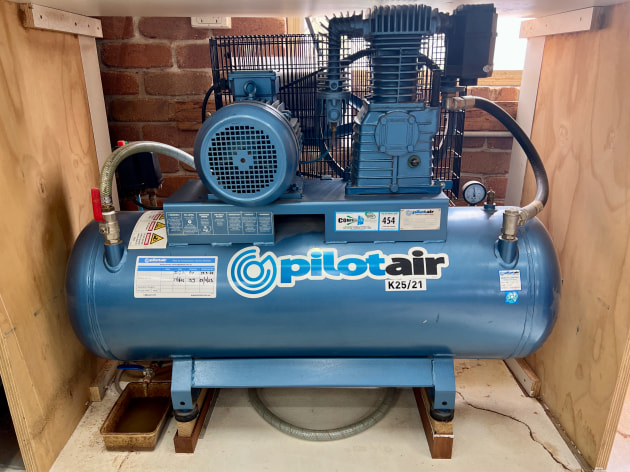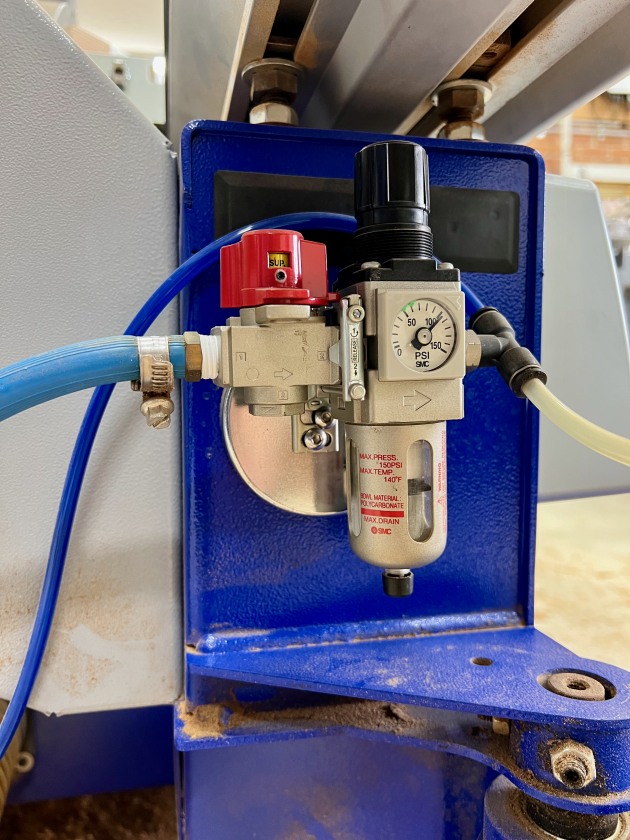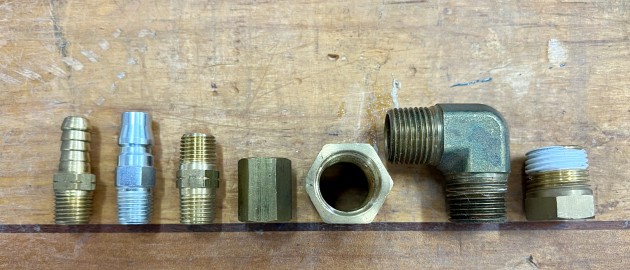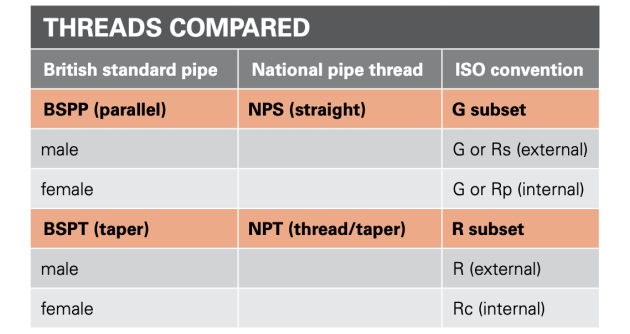Compressors explained: the power of air
Words and photos: David Luckensmeyer
Compressed air is a miraculous and sometimes scary energy source. Operating a pin nailer, cycling pneumatic clamps on and off, or spraying finish can be quite fun. But compressors are often loud, start when you least expect them to, and usually leak. And understanding the technical side can be daunting. Phrases like ‘free air delivery’, ‘tapered thread’ and ‘Nitto style’ get bandied around as if we’re all supposed to know exactly what they mean.
I’ve owned, installed and used many different compressed air systems in my time. My current steed is shown above. In this story I answer some key questions to help you choose whether to install a system in your workshop.
A generic filter-regulator is adequate. Pull up and rotate the black knob to adjust pressure, push down to lock. Most regulators also have a filter with drain (bottom).
What types are there?
There are many types of compressors on the market with inherent features to suit any budget, noise level requirement, longevity and use. For most woodworkers, a reciprocating piston compressor is perfect.
These come in several variants and your choice will be determined by those categories just mentioned. Inexpensive, oil-free compressors in the $150–500 price bracket are hard to overlook. They are often quiet (65–70 dB), lightweight and require little maintenance. On the downside, smaller units don’t always last and high-capacity oil-free compressors are expensive.
The main alternative is the oil- lubricated reciprocating piston compressor. These are typically noisy workhorses and cover a wide range of pricing and capacity (hundreds to thousands of dollars). The presence of oil is a plus/minus thing. They usually last longer but require more maintenance.

Oil-free units should provide up to 8 bar of pressure. Less is not enough for larger nail guns.
Both oil and oil-free compressors are available in single- and two-stage designs. The former are generally less expensive but louder (up to 90 dB). They compress air once. Larger, two-stage units are quieter (approx. 70–80 dB), run slower and compress air twice. They are also heavier, last longer and therefore cost more. You should consider a two-stage unit if your air-capacity requirements are higher or noise is a factor.
There are other types of compressors but they are not suitable for intermittent use which is what most woodworkers need. ‘Hydrovane’ and ‘rotary screw’ compressors are both exceptionally quiet (approx. 60–65 dB), extremely efficient and designed to run all day. Let’s be clear: ‘continuous duty’ does not mean it can run all day but that it must run all day (or most of the day). This is because vane and screw compressors need long periods of run-time at their operating temperatures. Otherwise, any water leaking into the compressors’ oil is not burned off and corrodes internal parts over time. My take-home message is to stick with reciprocating piston type compressors, either oiled or oil-free.

After destroying this hydrovane, I installed a 24 volt solenoid valve on a timer for my rotary screw so it would run continuously for two hours each day. Even with six monthly services, the unit did not last two years.
Definitions
Compressor: A machine that takes air from the shop and confines it to a smaller and smaller space. Pressurised air is delivered to a holding tank or ‘receiver’.
Pressure switch: Automatically controls the machine according to receiver pressure. Low and high pressure limits determine on/off cycles.
Filter-regulator: Limits or ‘regulates’ air pressure exiting the receiver. Different pressures are required for different user conditions.
Pressure: Measured in ‘bar’, ‘kilopascals’ (kPa), or ‘pounds per square inch’ (psi). A useful range for woodworking is 6–8 bar | 600–800 kPa | 87–116 psi.
Capacity: The ‘free-air delivery’ (FAD) or the amount of air discharged at a given pressure. Measured in litres per minute (L/min), or cubic feet per minute (CFM). A useful range for woodworking is 100–500 L/min | 3.5–17.6 CFM.
Condensate: The compression process releases a by-product of water or ‘condensate’, which may be removed by a dryer, filter, or other means.

A manifold allows multiple lines of air to be connected. Note the isolation ball valve at the top for maintenance. Condensate is eliminated at the bottom. The black quick- connect (with blue hose) is genuine Nitto while the quick-connect above is Nitto-style.
What are some infrastructure options?
My first air compressor had a single quick-connect outlet and a single hose. This worked well until I wanted more options across the shop. Now I regard compressed air as of equal importance to electricity distribution and dust extraction.
The best delivery systems involve installing rigid pipe around the shop and placing manifolds with filter/ regulators near machines or work areas. This avoids the potential of stumbling over air hoses and offers a way to manage condensate.
Copper pipe works well, is relatively inexpensive, and is my first preference. The proverbial aluminium ‘blue pipe’ is more expensive and not nearly as reconfigurable as advertised. I became sick of the leaks and trying to adjust O-rings while re-tightening fittings. Your experience may differ.

Condensate collects in the receiver which should be drained regularly.
Managing condensate is important. Moisture-laden air serves no good purpose. It adds a corrosion risk and can ruin projects (e.g. water in a sprayed finish). For most of us, a dryer (an additional machine that removes virtually all moisture from compressed air) is an unnecessary expense. Rather, use gravity to your advantage as follows.
First, horizontal pipes on shop walls or ceiling are to drain towards the receiver. Second, all vertical drops attach with an ‘up-and-over’ joinery system so the connection points are on top (see p.81), not the bottom where they would collect condensate. Third, a ball valve is installed at the bottom of every drop. With these three design strategies, condensate has little to no impact on my air quality, even in Brisbane which is relatively humid.

Copper pipe is not configurable but it does not leak either. Look online for videos on how to solder. Shown left to right: copper pipe, brass and copper fittings, silver solder, pipe cutters, wire brush, flux, propane torch.
What’s with all the jargon?
If you haven’t noticed, 1/4" and 1/2" compressed air pipes and fittings do not measure 6.35mm and 12.7mm. That’s because they’re classed according to a trade size. Until you become familiar with sizings, take fittings with you when you go shopping. Like router bit shanks, the imperial units persist.
Keep in mind that fittings have two sides. The trade size is only the half of it (literally). A typical joiner has a hose barb or thread on one side and another barb, thread, or quick- connect on the other. Both sides can be different sizes.
Left to right: 1/4" male thread to 3/8" hose barb, 1/4" male thread to Nitto quick-connect, 1/4" male thread coupling, 1/4" female thread coupling, 1/2" female thread coupling, 1/2" male thread elbow, 1/2" male thread plug.
Moving along, thread specifications are a quagmire I’d like to avoid. But they are hard to work out without help, especially if you’re new to all the abbreviations. Here’s a brief introduction.
Many Commonwealth countries including Australia use ‘British standard pipe’ (BSP) while Americans use ‘National pipe thread’ (NPT). Both standards are widely available in Australia although BSP is more dominant.
To complicate matters, these two thread systems come in parallel and tapered, and in two versions: male and female. And then there’s the ‘International organisation for standardisation’ (ISO) conventions which often crop up online or in machine manuals. See table opposite.
The NPT conventions for male and female versions are complicated and there is considerable confusion with other standards. I don’t want to get into that here.
BSP and NPT are generally not compatible. I use inexpensive adaptors where needed. Functionally, 1/2" BSP and NPT are compatible enough to work in a pinch because the thread pitch aligns for this size. Thread tape is essential for all joins.
It is good practice to focus on a standard size to reduce frustration. Use 1/2" pipe across your shop so you can maintain pressure. But unless you really need the high airflow at your machine or tool (unlikely), reduce to 1/4" fittings for your filter-regulators, ball valves, and joiners. The smaller size saves money.

A level may be used when installing horizontal pipes along shop walls. On the ceiling, graduated blocks ensure condensate drains towards the receiver.
What about quick-connects?
A quick-connect consists of female and male components. Components must be compatible as there are many different kinds and sizes. Some quick-connects are better than others. The standard in Australia is ‘Nitto- style’ but in my experience they are not worth the cost savings. Some work just fine while others leak upon installation or after a few months. ‘Nitto’ stands for Nitto Kohki, a Japanese company founded in 1956. Genuine Nitto fittings are very well made and therefore more expensive.
I’ve mostly moved away from Nitto because there are arguably better fittings available. ‘Legris’ and ‘Prevost’ quick-connects both have pre-release mechanisms to eliminate pressure before a full disconnection. Gone are the days of ear-splitting disconnections of tools under high pressure.
The up-and-over system consists of a three-way joiner, some pipe and two 90° elbows. These can be made at the bench and then soldered into place.
Legris and Prevost are not compatible with Nitto or Nitto-style male quick- connect couplings, as they are based on an ‘industrial standard’ from the USA. However, don’t be afraid to explore these fittings especially in today’s globalised market. I have both Legris and Prevost all over my shop and they are available in Australia.
The Prevost (bottom) depressurises at the press of a button while the Legris (middle) is turned one way for depressurising and then the other for a full disconnection. The Nitto quick-connect (top) is included for comparison.
Hose options?
Nitto make excellent, kink-free hoses in the larger sizes and lengths. But for 1/4" it is hard to beat other proprietary options like ‘Flexzilla’ hoses from Amazon Australia. These come with 1/4" NPT fittings and/or couplings and work wonderfully well. Of course there are many alternatives from which to choose.
Don’t forget push-to-connect options for an easy way to expand your delivery system. I thought these were cheap rubbish until I started using them. They work well in situations where you need permanent air. I use the 1/8" versions for pneumatic clamps and compressed air cleaning guns. The 1/8" coil hose size is fantastic because it is light and inexpensive. Larger coil hoses are reserved for blowing down the shop.

This assembly includes an isolating ball valve with condensate drain (left), a filter- regulator for adjusting pressure (middle)
and a manifold (right). Two Nitto quick- connects come off the manifold, one for the blue coil hose (Legris quick-connect and gun), and the other for the greenish ‘Flexzilla’ hose (for nail guns). The brass plug on top is for future expansion.
Compressed air uses
I use compressed air mostly for cleaning dust and chips away from work areas. A small compressor serves this purpose just fine. Likewise, a nail gun or pneumatic clamps might only need 100 L/min FAD at 8 bar. Even my large 15 kW wide-belt sander does not require much more air. Harnessing the power of air does not have to be expensive.
At the other end of the spectrum, pulsed-air cleaning systems on some dust extractors (e.g. my Felder RL250) and some air-driven tools can be real air hogs. The Felder requires large amounts of air; so much so that I maintain a 550 L receiver to provide the capacity required during the cleaning cycle.
Apply thread tape clockwise for leak-free connections. Tape applied anti-clockwise often unravels when fittings are screwed together.
In my assembly area I have several filter-regulators, coil hoses and reel hoses for headless pinners, and nail and
staple guns in various sizes. At each machine I’ve brought small hoses to a filter-regulator attached to the machine with a rare earth magnet. These service compressed air blow guns, several pneumatic clamps, and other pneumatic controls on a bandsaw feeder and a wide- belt sander pneumatic platen.
I don’t have a spray gun for finishing purposes but I confess I do covet. And if I didn’t have a vacuum system, I’d be looking at a Venturi model for vacuum bagging laminates. The use of compressed air in the shop is potentially extensive indeed.
David Luckensmeyer is a Brisbane-based woodworker and furniture maker, see www.luckensmeyer.com.au and Instagram @luckensmeyer
Adding coil hoses using push-to-connect fittings really is as simple as pushing the end of the hose into the fitting.










